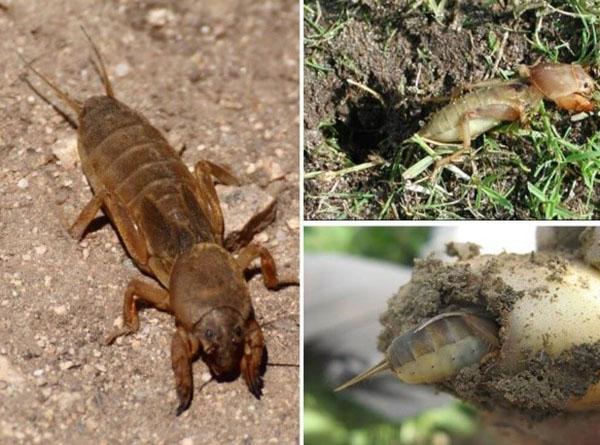Medvedka - who is she and why is it dangerous for gardeners
 Medvedka is perhaps one of the scariest insects that you can see in the garden or in the garden. In appearance, it resembles a crayfish, and many call it that - an earth crab, because it lives underground. If the bear has chosen your site, be sure that half of the harvest will have to be shared with her. What is this insect and what harm can it cause?
Medvedka is perhaps one of the scariest insects that you can see in the garden or in the garden. In appearance, it resembles a crayfish, and many call it that - an earth crab, because it lives underground. If the bear has chosen your site, be sure that half of the harvest will have to be shared with her. What is this insect and what harm can it cause?
What does a bear look like
The length of the bear can exceed 5 cm, with the abdomen occupying most of it. It is soft, but on top of the insect there is a hard brown shell, partially covering the head. It is soft at first, but hardens over time. To be able to grow further, the bear drops it. Eyes and long antennae are clearly visible on the head. The front pair of limbs is thickened, with denticles so that the bear can dig the ground. On the body there are two more pairs of legs, already ordinary, thin. The back has a pair of folded wings.
Medvedka belongs to the burrowing family of the Orthoptera order.
The bear comes out of its mink mainly at night, quickly running on the ground. She also swims and flies well. Winter is not terrible for the pest - it waits out of it, burrowing deeply into compost heaps or just into the ground.
How to distinguish a male from a female and how bear bears breed
You can find out who is currently in charge of the beds from afar, going out to the site in the evening. If you hear a characteristic loud sound, it is the males singing, inviting the ladies “on a date”. The volume of singing depends on the size of the male: the older and larger he is, the more vociferous. The sound also enhances the specific structure of the mink. Closer to the exit, it becomes wider, forming a kind of acoustic chamber. This allows the song to travel far beyond the home. For example, a bear living in our area can be heard 200 meters from the mink. There are also such species of insects, which are audible for more than 0.5 km.
In addition, female bears are several times larger than males. Moreover, there are usually more of them, so up to 2 dozen ladies can come to sing one gentleman. The chosen one or the most nimble of them penetrates the burrow and mates with the male. Then he lays eggs in a special rounded chamber. There can be up to 300 of them.
Having found a mink with a male, fill it with water. The bear will die, which means that the female will not be able to lay eggs and increase the pest population.
Young bears hatch from the larvae and at this age they are harmless. The length of the babies is only 3 mm, they are light yellow, almost do not move, and they receive nutrition thanks to the yolk in the goiter. Bears turn into a full-fledged adult insect by the second year of life.
Medvedka: what can "do" in the garden beds
Earthen crayfish feeds on small insects - worms and larvae. But the basis of the bear's diet is plant food, and she finds the most delicious "dishes" in our beds. So, the bear is enjoying herself with pleasure:
- sown seeds in spring;
- potato tubers;
- root crops;
- the roots of almost all garden plants, especially cabbage;
- ripe strawberries;
- apples, plums and pears that have fallen in the garden.
The bear does not disdain the roots of young trees, shrubs and even flowers. So, if you see her, take urgent action, otherwise your garden and vegetable garden will be in jeopardy.